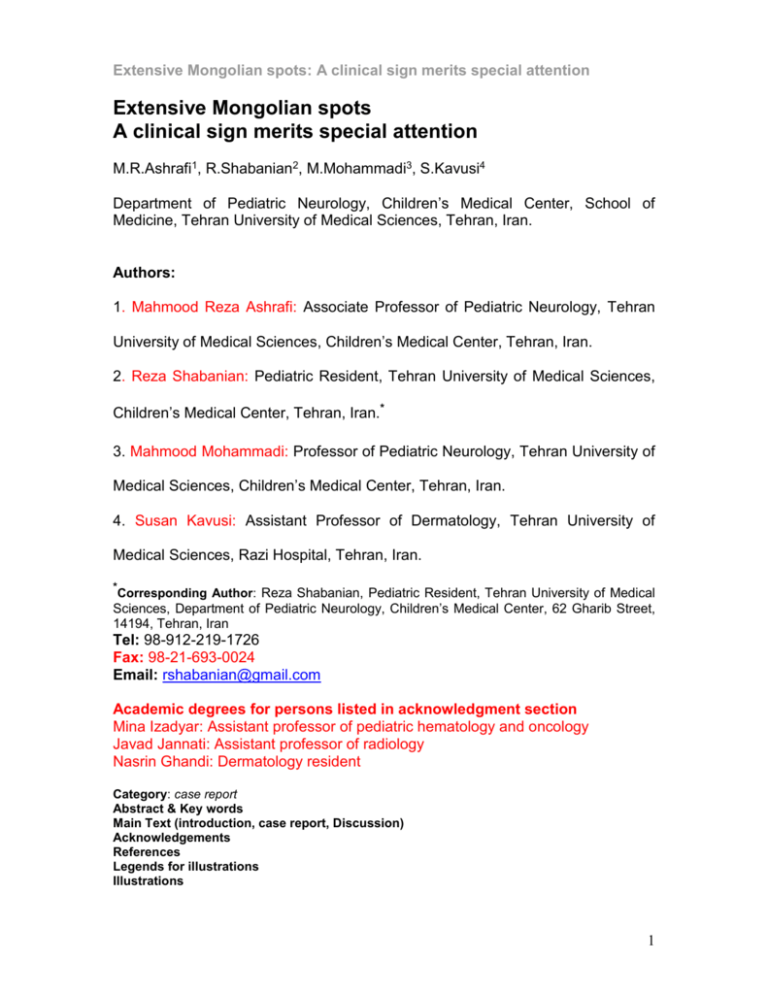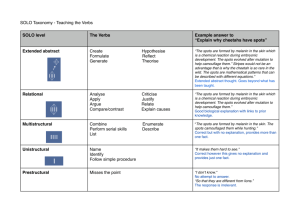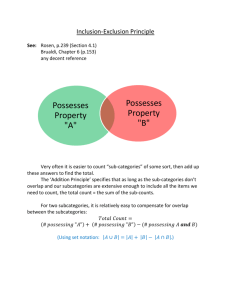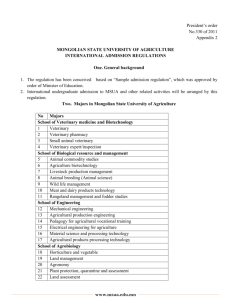Extensive Mongolian spots
advertisement

Extensive Mongolian spots: A clinical sign merits special attention Extensive Mongolian spots A clinical sign merits special attention M.R.Ashrafi1, R.Shabanian2, M.Mohammadi3, S.Kavusi4 Department of Pediatric Neurology, Children’s Medical Center, School of Medicine, Tehran University of Medical Sciences, Tehran, Iran. Authors: 1. Mahmood Reza Ashrafi: Associate Professor of Pediatric Neurology, Tehran University of Medical Sciences, Children’s Medical Center, Tehran, Iran. 2. Reza Shabanian: Pediatric Resident, Tehran University of Medical Sciences, Children’s Medical Center, Tehran, Iran.* 3. Mahmood Mohammadi: Professor of Pediatric Neurology, Tehran University of Medical Sciences, Children’s Medical Center, Tehran, Iran. 4. Susan Kavusi: Assistant Professor of Dermatology, Tehran University of Medical Sciences, Razi Hospital, Tehran, Iran. * Corresponding Author: Reza Shabanian, Pediatric Resident, Tehran University of Medical Sciences, Department of Pediatric Neurology, Children’s Medical Center, 62 Gharib Street, 14194, Tehran, Iran Tel: 98-912-219-1726 Fax: 98-21-693-0024 Email: rshabanian@gmail.com Academic degrees for persons listed in acknowledgment section Mina Izadyar: Assistant professor of pediatric hematology and oncology Javad Jannati: Assistant professor of radiology Nasrin Ghandi: Dermatology resident Category: case report Abstract & Key words Main Text (introduction, case report, Discussion) Acknowledgements References Legends for illustrations Illustrations 1 Extensive Mongolian spots: A clinical sign merits special attention Extensive Mongolian spots A clinical sign merits special attention Abstract Although typical and limited Mongolian spots are benign skin markings at birth which fade and disappear as the child grows, extensive Mongolian spots deserve special attention as possible indications of associated inborn error of metabolism. A few cases of extensive Mongolian spots in association with inheritable storage diseases have been reported. Some hypotheses have been put forward, but further investigation is necessary to elucidate the causative factors. We describe 3 infants with generalized Mongolian spots, two infants with GM1gangliosidosis type1 and one in association with Hurler syndrome. Findings of generalized Mongolian spots in newborns may lead to an early detection and early treatment before irreversible organ damage occurs. Keywords: Mongolian spots, inborn error of metabolism, GM1gangliosidosis, Hurler syndrome, dermal melanocytosis. 2 Extensive Mongolian spots: A clinical sign merits special attention Introduction Mongolian spots are blue or slate-gray macular lesions occurring most commonly in the sacral area but also found over posterior thighs, legs, back and shoulders. They may be solitary or numerous. Generalized or extended Mongolian spots involve large areas over the entire posterior and anterior aspects of the trunk and extremities. Mongolian spots usually fade during the first few years of life but they occasionally persist. Those associated with inborn error of metabolism (IEM) such as GM1gangliosidosis and Mucopolysaccharidosis show no sign of resolution. They may also become heavier in their colors [1, 2, 3]. The potential association of generalized Mongolian spots with inheritable storage disease has been described but still their relationship is poorly understood. We describe 3 infants with generalized Mongolian spots in association with IEM. 3 Extensive Mongolian spots: A clinical sign merits special attention Case report Case1. A male infant who was born to consanguineous parents after a normal vaginal delivery was seen at the age of 12 months for delayed developmental milestones. He had coarse face, frontal bossing, hepatosplenomegaly, bilateral inguinal hernia and widespread Mongolian spots extending over the back and upper and lower extremities (Fig 1). He had an exaggerated startle response to noise. Skeletal bone survey showed paddle- shaped ribs, beaking of lumbar vertebral bodies and flaring of iliac wings resembling skeletal abnormalities seen in mucopolysaccharidosis. Liver function tests showed elevated transaminases. Urine was negative for mucopolysaccharides. BMA revealed numerous foamy cells (sea blue histiocytes) in favor of storage disease. Skin biopsy showed dermal spindle cell melanocytic proliferation associated with focal ectasia (Fig 2). Cherry red spot was seen in fundoscopic examination. galactosidase activity in leukocytes was absent. He had GM1gangliosidosis. Case2. A 15-month-old boy of consanguineous parents came to observation due to neurodevelopmental regression. In physical examination he had coarse facial feature hepatosplenomegaly, kyphosis, bilateral umbilical hernia, nystagmus, spasticity, psychomotor retardation and extensive Mongolian spots. Skeletal bone survey showed osteoporosis, paddle shaped ribs and beaking of a lumbar vertebral body. In fundoscopy he had cherry red spot of the retina. The report of numerous foamy cells in bone marrow aspiration supported a diagnosis of storage disease (Fig 3). galactosidase activity was undetectable 4 Extensive Mongolian spots: A clinical sign merits special attention in peripheral leukocytes consistent with the diagnosis of GM1gangliosidosis type1. He died five months later. Case 3.The third patient was a five–month-old male infant, product of nonconsanguineous parents, presenting with recurrent upper respiratory tract infection, persistent noisy breathing and vomiting after breast feeding. Two siblings died at 8 months of age due to cardiac complication probably cardiomypopathy. He had coarse facial features, wide-apart eyes, and a depressed nasal bridge. He also had harsh breath sounds, hepatosplenomegaly, right inguinal hernia and extensive blue Mongolian spots on the back, buttock and distal extremities. Echocardiography showed cardiomayopathy. Urine analysis for MPS was positive. He had corneal clouding. Cherry red spot was not seen in retinal examination. Bone marrow aspiration was unremarkable. Enzyme assay established the definitive diagnosis of MPS (Hurler syndrome). He died because of infection 45 days after bone marrow transplantation. Parents of these three patients expected that these blue spots would fade and disappear with passing time (according to their physicians’ prognoses), but in these cases the Mongolian spots neither faded nor disappeared. Furthermore, in two cases, the spots became darker. . 5 Extensive Mongolian spots: A clinical sign merits special attention Discussion Mongolian blue spots or dermal melanocytosis are birth marks with wavy borders and irregular shapes [3, 4]. Among different ethnic groups, over 90% of Native Americans and people of African descent, about 80% of Asians, about 70% of Hispanics and fewer than 10% of Caucasians have Mongolian spots [4]. A study in 1976 showed the presence of Mongolian spots in about 40% of Iranian newborns [5]. The sacral area is the classic site of involvement. Typical and limited Mongolian spots are benign skin markings, commonly appear at birth or shortly after, and are not associated with any disorder .They generally fade in a few years and disappear by puberty. However, extensive Mongolian spots which involve large areas of the posterior and anterior aspect of the trunk and extremities deserve special attention. A retrospective review of the literature revealed that the combination of extensive Mongolian spots and inborn error of metabolism may not be coincidental [1, 3, 6]. This is the first case report from Iran since 1981, when Weissbluth et al first recognized the relationship between IEM and extensive Mongolian spots [7]. By reviewing the last 10 years’ medical records of patients admitted in Children Medical Center that is a referral center for pediatric neurometabolic disorders in Iran, we did not find any report of extensive Mongolian spots associated with IEM. This may be due to the belief that Mongolian spot is a benign skin marking with high prevalence in Asian newborns. It is obvious that a comprehensive study is necessary to follow infants with extensive and ectopic Mongolian spots for IEM, to determine the association and the predictive value of this clinical sign. 6 Extensive Mongolian spots: A clinical sign merits special attention The most common lysosomal storage disease associated with generalized Mongolian spots is Hurler syndrome followed by GM1gangliosidosis type1 [3]. A literature review revealed 39 cases of lysosomal storage disease associated with dermal melanocytosis. 24 cases had Hurler disease and 11 patients were suffered from GM1gangliosidosis type1 [3]. An association with Niemann_pick disease, hunter and _mannosidosis was also reported [1, 3, 8, 9, 10]. In these conditions hyperpigmentation is a long–lasting symptom. Histopathologic examination of skin lesion shows elongated dermal melanocytes with fine melanin pigment. Electron microscopic examination shows that the dermal melanocytes are similar to those seen in the developmental stage of common Mongolian spots in normal infants [3, 8]. In cases of lysosomal storage disease, ultra structural features of melanocytes in the biopsy specimen from unaffected skin show a higher concentration of empty lysosomal vacuoles compared to menalocytes of lesional skin. It is assumed that with the progressive accumulation of metabolites and neurological deterioration, the lysosomal vacuoles are simply displaced or reabsorbed as melanocytes activation continue to progress in the affected skin. Mongolian spots result from entrapment of melanocytes in the dermis because of arrested transdermal migration from the neural crest into the epidermis. Exogenous peptide growth factors through activation of receptors with tyrosin kinase properties regulate this migration. Some experts noted that accumulated metabolite such as GM1 and heparan sulfate bind to this tyrosin kinase-type receptor (Trk) which enhances nerve growth factor activity and leads to both severe neurologic manifestation and 7 Extensive Mongolian spots: A clinical sign merits special attention aberrant neural crest migration. Since melanocytes have chemotropic receptors for nerve growth factor, metabolite-Trk binding may lead to arrested melanocytes transdermal migration. However further investigation is necessary to confirm the role of growth factors (e.g. hepatocyte growth factors) and Homebox gene in the pathogenesis of dermal melanocytosis [3]. Better prognoses in cases with early application of stem cell transplantation or recombinant enzyme therapy emphasize the importance of early diagnosis in children before irreversible organ damage occurs. A proven clinical correlation could lead to early diagnosis and treatment of IEM in these patients with extensive Mongolian spots, identification of at-risk families, and prevention of complications. Proving this correlation will require more cases to be reported and more comprehensive investigations. If this correlation is proved in future, a workup for inborn error of metabolism will be necessary for all newborns with extensive Mongolian spots. Until that time, close observation of patients with extended and ectopic Mongolian spots, especially in cases with positive family history, seems to be useful. 8 Extensive Mongolian spots: A clinical sign merits special attention Acknowledgements We appreciate Dr. Mina Izadyar MD, Dr Javad Jannati MD and Dr Nasrin Ghandi MD for their help and cooperation. 9 Extensive Mongolian spots: A clinical sign merits special attention References 1. Silengo M, Battistoni G, Spada M. Is there a relationship between extensive Mongolian spots and inborn error of metabolism. American J of Med Genetics 1999; 87:276-277. 2. Ochiai T, Ito K, Okada T, Chin M. Significance of extensive Mongolian spots in Hunter’s syndrome. British J of Dermatology 2003; 148:1173-78. 3.Hanson M, Lupski J, Hicks J, Metry D. Association of dermal melanocytosis with lysosomal storage disease. Arch Dermatology 2003; 139:916-920. 4. Jacobs AH, Walton RG.The incidence of birthmarks in the neonate. Pediatrics 1976; 58:218-222. 5. Valizadeh G. Mongolian spots and its prevalence in Iranian newborns .J of Iran Medical Council.1976; 4:352-353. 6. Rybojad M, Moraillon I, Prigent F, Morol P. Extensive Mongolian spot related to Hurler disease. Ann Dermatol Venerol 1999; 126(1):35-7. 7. Weissbluth M, Esterly NB, Caro WA. Report of an infant with GM1gangliosidosis type1 and extensive and unusual Mongolian spots. Br J Dermatol. 1981; 104: 195-200. 8. Sapadin AN, Friedman IS. Extensive Mongolian spots associated with Hunter syndrome .J Am Acad Dermatol 1998; 39:1013-15. 9 Camur S, Coskun T, Kiper N. Alpha-mannosidosis :The first Turkish case . Acta Paediatr Jpn 1995; 37:230-232. 10.Pinto LIB,Richachnevski N, Paskulin GA, Mendez HMM. Extensive Mongolian spots and inborn error of metabolism. Am J Hum Genet.1990; 49:s156. 10 Extensive Mongolian spots: A clinical sign merits special attention Legends for illustrations Fig 1- Generalized Mongolian spots over the back and also upper and lower extremities of an infant with GM1gangliosidosis type 1. Fig 2-Skin biopsy obtained from blue spots showing dermal spindle cell melanocytic proliferation (black arrows) with focal ectasia in an infant with GM1gangliosidosis type1. Figure 3–Foamy cell or sea blue histiocyte (black arrow) in the bone marrow aspiration of an infant with GM1 gangliosidosis type1. 11




